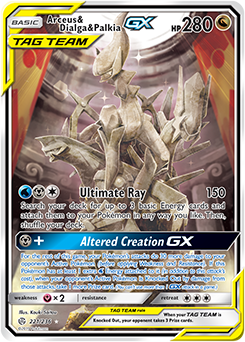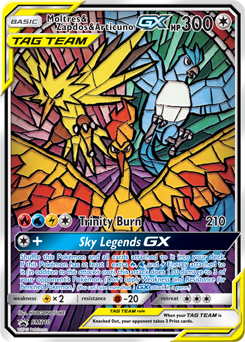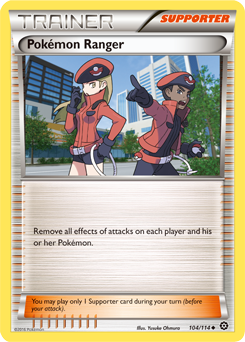Everyone’s Favorite Tag Team Revisited — ADP in Expanded
Hello everyone! With Shining Fates still a little bit away, not much is new in the Standard format, so in this article, I’ll be again taking a look at the newly changed Expanded format. To keep with my last article’s theme of “good cards in both formats”, I’ll coincidentally be going over one of the defining cards of Standard; Arceus and Dialga and Palkia-GX.

While some players do love this card, many others can’t wait for this card to rotate out of Standard — some tournament series have even gone so far as to ban it. There has been some level of debate on whether or not the card is simply too good, including whether or not a banning of it in Standard would be justified, or if players should simply wait until the 2021 rotation naturally moves it out of the Standard format. In either case, the card will only be around for six months or so, but thankfully for its fans, there is a format where you can never escape ADP’s wrath; Expanded!
It turns out that ADP is an incredible card in Expanded, as it is in Standard. Not only does the increased speed of the format naturally go well with ADP’s aggressive strategy, but it is also easier to utilize, it is more consistent, and there are more decks that can take advantage of it. Unsurprisingly, a strategy that wins you the game in only three turns is exceptionally strong regardless of format… There are a few downsides, of course — there is one notable reason why players have yet to call for ADP to be banned in Expanded — but it is nonetheless a great card to include in many decks. Again, if you’re looking for familiarity when jumping to Expanded from Standard, ADP is a great choice, but it doesn’t have to be the same old thing, as there are numerous creative ways to utilize the card. The neat thing about this card in Expanded is that unlike in Standard, where it seems to be a format limiter, in Expanded, it actually increases the number of decks that can be considered viable.
So, whether you want to keep playing Zacian V, or want to play something new and creative, there is a good chance that ADP can allow you to play what you want, and still help you to achieve your winning goals.
Advantages and Disadvantages in Expanded
When evaluating ADP in Expanded, it does make some sense to compare it to its Standard equivalent. The biggest advantages the card has in Expanded is that it is easier to use (and more consistent), that it has more versatility, and that it works well in the somewhat faster Expanded format. The biggest disadvantages that it has is that it is a bit easier for an opponent to Knock Out ADP on the turn following Altered Creation GX, and the existence of Pokémon Ranger.
Preparing for Pokémon Ranger
Before I go over ADP itself, I do want to go over the threat of Pokémon Ranger, as it certainly represents a huge potential problem for any deck that builds around using Altered Creation GX. In Standard, once Altered Creation GX is used, there’s no way to undo it, so a player who uses it will be guaranteed to have that advantage for the rest of the game. In Expanded, you can completely erase the effects of Altered Creation GX simply by using a Pokémon Ranger. In theory, this is awful for ADP, since any deck can easily throw in a tech to deal with it. What’s more, if you do use Altered Creation GX and have that effect erased, not only have you wasted a valuable turn of attacking, but you’ve also wasted your GX attack for that game. Pokémon Ranger gives Expanded players a form of counter-play against ADP — something that does not exist in Standard — and thus is a major reason why ADP isn’t considered a game-warping card in the Expanded format. Prior to the pandemic, the threat of Pokémon Ranger meant that ADP, while good, was a somewhat risky play at the Regional Championships, however, the switch to online events has provided an unexpected boost to ADP when it comes to this issue.
An interesting twist to the online tournament circuit is that unlike in in-person events, most online events have it so that decklists are public. While the intention here is to be an anti-cheating measure, this change nonetheless does have a significant impact on the effectiveness of certain strategies. With public decklists, you won’t have the surprise factor from anything unexpected, since your opponent will know in advance about any and all cards in your list. Public decklists also give advantages to some specific strategies, which notably includes ADP.
So, why exactly do public decklists give Arceus and Dialga and Palkia-GX players an advantage? It is because, by knowing your opponent’s list in advance, you will know whether or not they play Pokémon Ranger. If they don’t play Pokémon Ranger, then you’ll know that you can use Altered Creation GX without any possibility of it being a wasted attack. On the other hand, if they do play Pokémon Ranger, then you can plan ahead for it. In that latter case, you can simply opt to not use Altered Creation GX, and only use ADP for Ultimate Ray, if at all. Depending on your deck, you’ll then know that an alternative GX attack is the best move. This is in stark contrast to a format without open decklists, where you might plan to use Altered Creation GX regardless, and hope that your opponent doesn’t have Pokémon Ranger, knowing that if they do, you’ve likely wasted an attack. By knowing in advance, you can eliminate that guesswork, and likewise eliminate any potential misplays that might arise from the lack of information. Because of this specific change, ADP decks become much better than they would otherwise.
Now that we’ve covered that, let’s take a look at some of the advantages that ADP gains when moving to the Expanded format.
Ease of Use
The biggest advantage that ADP has in Expanded is how much easier it is to use Altered Creation GX. In Standard, to use a turn-one Altered Creation GX, you need to find a Water Energy, find a Metal Energy, figure out a way to discard that Metal Energy, find a Metal Saucer and a Metal Pokémon to use it on, and then find an Energy Switch to make it all work. In contrast, in Expanded, you need to attach a Double Dragon Energy to your ADP. That’s all! To make things even easier, Double Dragon Energy is easily searched out with Guzma and Hala, which can simultaneously find a Float Stone if needed. Given that Tapu Lele-GX can find that Supporter, you can also include any Pokémon-searching Items as an out to find Double Dragon Energy. For example, in the Dark Box list below, you have 14 such outs to find Double Dragon Energy, plus the two-card Battle Compressor + VS Seeker combo. With that many ways to search out Double Dragon Energy, the chance of missing it is incredibly low, to the point that you can reasonably rely on hitting the turn-one Altered Creation GX in every game in which you go second. That level of consistency is tremendous and naturally makes ADP a much stronger card.
More Ways to Play

Largely due to the increased ease of use, Expanded also has increased options for Pokémon that you can pair with ADP. In Standard, the Metal / Water Energy requirements mean that you are pretty limited in what you can play ADP with. Aside from Zacian V / Metal box, there aren’t any other Pokémon that go well with it, and certainly, none that are as good as Zacian V. In Expanded, you can effectively play the card in anything that can utilize Double Dragon Energy, in addition to any Metal decks. In theory, you don’t even have to already play Double Dragon Energy in your deck — you can simply add a few copies, along with Guzma and Hala. Excellent examples of decks that were able to succeed by throwing in ADP that way include Blacephalon-GX and Moltres and Zapdos and Articuno-GX, despite the fact that neither naturally play Double Dragon Energy or Metal Energy. Realistically, you could throw that ADP package into any deck if you wanted to — the possibilities are endless!
With that said, there are a few criteria that are worth considering to help find ideal pairings. For example, it wouldn’t make sense to add ADP into a stall or mill deck, or any deck where taking Prizes isn’t the priority. The three largest factors on whether or not ADP will fit well into a deck are 1) does the deck already naturally play Double Dragon Energy or Metal Energy, 2) how much will Ultimate Ray help the deck’s strategy, and 3) how much will Altered Creation GX improve the deck’s matchup spread.
If a deck does already play Double Dragon Energy, then it will be quite easy to include a copy of ADP in the deck. For example, I’ve taken to including a copy of ADP in my Garchomp and Giratina-GX list — since I already play both Double Dragon Energy and Guzma and Hala, including ADP requires only a one-card change. Since you know in advance whether or not you’ll be able to gain the advantage from Altered Creation GX (or if your opponent plays Pokémon Ranger), it makes it much easier to add it as a tech, since you can choose to only use it against opposing decks where it will confer an advantage. Given how strong that advantage is, ADP is well worth the one card spot. If the deck doesn’t already play Double Dragon Energy, that doesn’t mean you can’t or shouldn’t play ADP in it, but it does mean that you’ll have to take out a few more cards in order to include it. Likewise, this means that you’ll want ADP to give you a larger advantage relative to decks that already play Double Dragon Energy — this is where the second and third factors come in.
My second factor actually has nothing to do with Altered Creation GX, but rather whether or not Ultimate Ray will be useful. If it is, this means that ADP will be a helpful addition even in matchups where Altered Creation GX isn’t worth using, or if your opponent plays Pokémon Ranger. Most of the successful ADP lists in Expanded have been decks that take full advantage of Ultimate Ray, such as the two aforementioned examples. The Pokémon to look for in this regard are either ones that do more damage when more Energy is on the board or ones with larger or more unwieldy Energy requirements. Something like Night March or Zoroark-GX wouldn’t fit this criterion then, since Ultimate Ray would typically be a less-than-ideal attack in those decks, given that they wouldn’t gain much from the Energy acceleration.
After that, the third thing I consider is a deck’s matchups — does the deck struggle otherwise against single-Prize attackers? If so, Arceus and Dialga and Palkia-GX will be worth considering, as Altered Creation GX is most impactful against those kinds of decks. On the other hand, if the deck in question is only weak against Tag Team or VMAX decks, ADP won’t be terribly helpful, since Altered Creation GX won’t actually reduce the number of attacks you need to use to win.
Advantages and Disadvantages of a Faster Format
This somewhat goes with the above topic, as the faster speed of many decks means that more decks have an aggressive strategy that ADP can assist with. More importantly, the faster the format, the more aggressive opposing decks have to be in order to keep up. This means that many decks will naturally have to rely on cards such as Dedenne-GX, Crobat V, and Tapu Lele-GX — all of which represent easy Prizes for an ADP player. This factor also can work against ADP, however, as Expanded decks are more likely to be able to pull off a KO on the turn following Altered Creation GX. If the opponent can do so, then they can win the Prize trade even after a first-turn Altered Creation GX, regardless of whether they use single or multi-Prize attackers. Overall, it is still quite difficult to deal 280 damage on turn two, but it is far more likely to run into that scenario in Expanded.
ADP General Strategy
For many decks that use ADP, the general strategy is pretty similar, especially in cases where the opponent does not play Pokémon Ranger. When playing ADP, you’ll always want to go second, so that you can use Altered Creation GX on your first turn. On that first turn, you’ll want to prioritize using Altered Creation GX, which generally means finding an Arceus and Dialga and Palkia-GX, then finding a Guzma and Hala. If you don’t have the resources to get those cards in hand, don’t hesitate to use Crobat V and Dedenne-GX — if you can get off the T1 GX attack, it won’t matter if your opponent can get cheap Prizes by KOing those Pokémon. Typically, you don’t want to use a Supporter that is not Guzma and Hala unless you either already have the Double Dragon Energy attached, or if you can’t possibly pull off the T1 attack unless you play a different Supporter. Occasionally, you may have to play the Guzma and Hala simply to find a Float Stone to retreat (if you already have ADP and Double Dragon Energy) — if this is the case, you should certainly do so, as the guarantee is more valuable than any additional resources you might get by being risky and playing, say, a Professor Juniper instead.
After you’ve used Altered Creation GX, your next move will be to pick out some Pokémon-GX to KO, and take those Knock Outs. Like in Standard, the ideal move here will be to do so by using Ultimate Ray, as that can set you up for a guaranteed win on the following turn. If in doubt, take out any attacking threat, before taking out easy Prizes like Dedenne-GX. Guzma is incredibly valuable at this point, so you’ll want to do what you can to maximize your odds of finding it, even if you encounter hand disruption. A good move will be to get Guzma into your discard pile via Battle Compressor, as you can then retrieve it with VS Seeker. If your VS Seeker is prized, you’ll want to leave it in your deck to grab with Tapu Lele-GX (assuming you haven’t used it already). Ideally, you should win in three turns, or four if your opponent maintains a field entirely of single-Prize Pokémon. Do remember that Parallel City and AZ are potential ways for your opponent to remove GX Pokémon from the field, so try to have a backup plan in case they are able to do so.

If your opponent does happen to play Pokémon Ranger, then you will generally want to avoid using Altered Creation GX unless there happens to be no better option. Generally, if you do manage to use it on turn one, you’ll get some use out of it even if your opponent does play Pokémon Ranger. This is because it can be difficult to set up without the use of a draw Supporter on both turn one and turn two (remember, they can’t play one T1 when going first). Against single-Prize decks, that effect is even more prominent, since the opponent won’t be able to use consistency Pokémon (like Dedenne-GX or Crobat V) while still maintaining a board of exclusively single-Prize Pokémon. This also is a decent reason to try and use Altered Creation GX even if you are in a game where you happen not to know your opponent’s decklist (such as on the PTCGO ladder), especially given the large benefit in the case that they don’t play it.
If you do know that your opponent plays Pokémon Ranger, and you do have a better option, however, then you’ll want to use that other option. Depending on your deck, you may still want to use ADP for Ultimate Ray, though whether or not that is a good play depends entirely on the two decks in the match. If you’re playing a deck like Garchomp and Giratina-GX or Ultra Necrozma-GX, where you’ve splashed in a one-of copy, then it is best to ignore ADP; if you’re playing a deck that takes advantage of Energy acceleration, then using Ultimate Ray tends to be a solid strategy.
This concludes the public portion of this article.
If you'd like to continue reading, consider purchasing a PokeBeach premium membership! If you're not completely satisfied with your membership, you can request a full refund within 30 days.
Each week we post high-quality content from some of the game's top players. Our article program isn't a corporate operation, advertising front, or for-profit business. We set our prices so that we can pay the game's top players to write the best content for our subscribers. Each article topic is carefully selected, goes through multiple drafts, and is touched up by our editors. We take great pride in our program!

